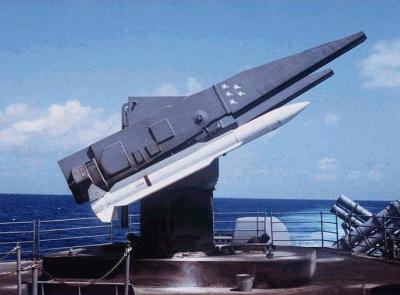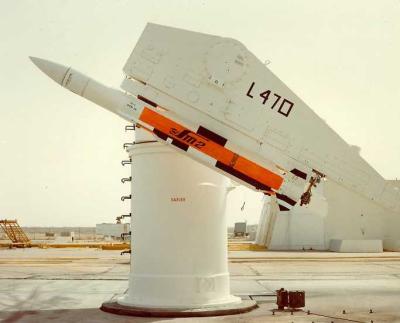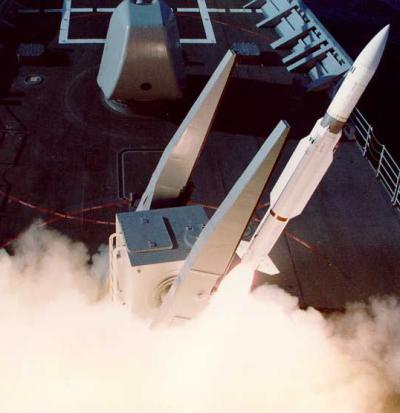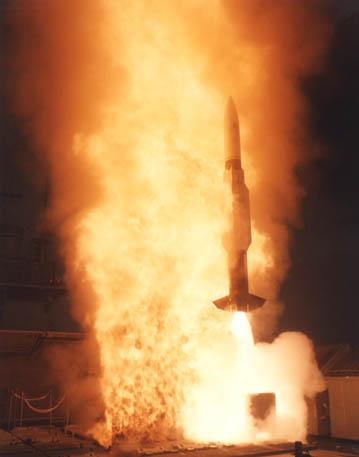Raytheon (General Dynamics) RIM-66 Standard MR
The Standard missile program was initiated in 1963 to provide a replacement for the RIM-2 Terrier and RIM-24 Tartar missile systems. The Tartar replacement was designated RIM-66 Standard MR (Medium Range), while the longer-range Terrier replacement became the RIM-67 Standard ER (Extended Range). The Standard is still the U.S. Navy's main medium and long range air defense missile.
The Standard MR and ER both use the same basic missiles, to which a booster stage is added in the ER version. The basic missile is externally very similar to the later Terrier and Tartar models. The original Standard missiles are also generally known as SM-1 (Standard Missile 1). The main improvements of the Standard over the earlier missile are solid-state electronics and all-electric internal power (e.g. electrically instead of hydraulically operated control surfaces), which greatly improves missile realiability and significantly shortens reaction time. Standard also had a new MK 1 autopilot, which could adapt to changes in the missiles dynamic parameters (e.g. velocity and atmospheric pressure).
The YRIM-66A began flight tests in 1965, and the RIM-66A SM-1MR Block I entered service in 1967. It had the same MK 27 dual-thrust rocket moter as the RIM-24 Tartar, a 62 kg (137 lb) MK 51 continuous-rod warhead, and a conscan radar seeker. Slight improvements for the RIM-66A resulted in the Block II, Block III, and Block IV. Block IV was the main production variant of the RIM-66A, and featured ECCM improvements, reduced minimum range, and a shortened acquisition time for surface targets. It entered service in 1968, and many earlier Block III missiles were later converted to this standard.
 |
| Photo: FAS |
| RIM-66A |
The SM-1MR Block V was designated RIM-66B, because it introduced more significant changes. It had a new plane-scanning seeker, a faster-reacting autopilot, a new MK 90 blast-fragmentation warhead, and a new Aerojet MK 56 dual-thrust rocket motor. The latter increased missile length by 25 cm (10 in), and increased range and ceiling by about 45 percent and 25 percent, respectively.
The final SM-1MR version was the Block VI, designated RIM-66E (RIM-66C/D versions are SM-2, see below). The RIM-66E featured the monopulse seeker of the SM-2, and a new MK 45 MOD 4 proximity fuze (also known as TDD - Target Detection Device). Production began in 1980, and the RIM-66E entered service in 1983. It is still in production for export customers. The subvariants of Block VI include RIM-66E-1/3/7/8 (-3/8 have the MK 115 warhead of SM-2). Block VIA (RIM-66E-5) and Block VIB (RIM-66E-6) had later MODs (6 and 7, respectively) of the MK 45 fuze for improved performance against low-RCS targets, and both use the MK 115 warhead.
SM-2 (Standard Missile 2) was developed as the missile component of the U.S. Navy's Aegis fleet air defense system. The SM-2 missile uses semi-active radar homing only in the terminal intercept phase, and has a new inertial guidance unit and a new programmable MK 2 autopilot to guide it near the projected point of intercept. On Aegis ships, this autopilot is command-guided to the target by the launching ship, which can track multiple targets with the Aegis' powerful AN/SPY-1 radar (current version is AN/SPY-1D). When used on earlier Tartar ships, SM-2 uses pre-launch settings and its inertial guidance system to find its way to the target. Not needing SAR guidance through all its flight-path, effective intercept range of the SM-2MR is 60 percent greater than for the SM-1MR. The command guidance allows a more energy-efficient flight path, and the illuminator radar (e.g. AN/SPG-62) can provide effective illumination at almost doubled target ranges (because illumination immediately after launch is especially power-demanding, when the radar beam has to travel all the distance from ship to target and back). A further improvement in the SM-2 is the new monopulse seeker for terminal homing, which provides better ECM resistance.
The RIM-66C designation applied to SM-2MR Block I missiles for Aegis ships. It had a MK 115 blast-fragmentation warhead. RIM-66C entered service in 1978 and was produced until 1983. RIM-66D is the SM-2MR missile for Tartar ships.
 |
| Photo: General Dynamics |
| RIM-66C |
All Standard missiles had inherent surface-to-surface capability. But there were also versions designed specifically as ship-to-ship weapons. The RGM-66D SSM-ARM (Surface-to-Surface Missile/Anti-Radiation Missile) was a relatively simple development of the RIM-66B SM-1MR Block V, which used an anti-radiation seeker to home on enemy ship radars. The designation RTM-66D was applied to a training version of the RGM-66D. The RGM-66E was a version of the SSM-ARM for use with the ASROC launcher. The RGM-66F was a projected active radar homing anti-ship missile. It was to have a monopulse doppler radar, which was briefly tested in 1973, but the RGM-66F was cancelled in 1975.
SM-2MR Block II introduced an improved Thiokol MK 104 rocket motor, to deal with faster and more manoeuverable targets. The effective range is almost doubled, reaching the limits of illuminator power. Block II also has a new high-velocity fragmentation warhead. The RIM-66G is the Aegis version, RIM-66H is for vertical launch on Aegis ships with MK 41 VLS (Vertical Launch System), and RIM-66J is for Tartar ships. SM-2MR Block II entered service in 1983.
 |
| Photo: U.S. Navy |
| RIM-66G |
SM-2MR Block III introduced an improved MK 45 MOD 9 TDD (Target Detecting Device) for better performance against low-altitude targets. Block IIIA has a new MK 125 warhead with heavier grain explosive, and Block IIIB (for Aegis/VLS only) incorporates an MHIP (Missile Homing Improvement Program) combined radar/IR seeker for terminal homing. The IR sensor is in a side fairing of the missile. The MHIP seeker was also intended for the cancelled AIM/RIM-7R Sparrow missile. The designation RIM-66K applies to Tartar system missiles (RIM-66K-1 Block III, RIM-66K-2 Block IIIA), RIM-66L is the Aegis missile (RIM-66L-1 Block III, RIM-66L-2 Block IIIA), and RIM-66M is the Aegis missile for the MK 41 VLS (RIM-66M-1 Block III, RIM-66M-2 Block IIIA, RIM-66M-5 Block IIIB). Block III production began in 1988, with the Block IIIA following in 1991. Blocks IIIA and IIIB are the current production versions.
A recent version of the missile is the RIM-66N Block IIIAZ, which is designed for use in the MK 57 PVLS (Peripheral Vertical Launch System) of Zumwalt (DDG 1000) class destroyers. It features a JUWL (Joint Universal Weapon Link) and ICWI (interrupted continuous wave illumination) support to make it compatible with the ships' AN/SPY-3 radar.
 |
| Photo: U.S. Navy |
| RIM-66M-2 |
In 2018, the Navy awarded Raytheon a development contract for the SM-2 Block IIIC. This version replaces the missile's seeker with the dual-mode semi-active/active radar seeker of the RIM-174 SM-6, and adds a new dorsal fin design and a jet vectoring tab for enhanced trajectory control after launch. A further upgrade, which replaces the Guidance Section Electronics Unit, is known as Block IIICU. Test firings of SM-2 Block IIIC missiles began in July 2022. The designation RIM-66P, which was allocated to an Aegis VLS variant of the SM-2 in 2018, might refer to the Block IIIC upgrade.
The following table summarizes the SM-1/2 block numbers and RIM-66 designation suffix letters for the Standard MR missile.
| RIM-66A | SM-1MR Block I-IV |
| RIM-66B | SM-1MR Block V |
| RIM-66C | SM-2MR Block I (Aegis) |
| RIM-66D | SM-2MR Block I (Tartar) |
| RIM-66E | SM-1MR Block VI (RIM-66E-1/3/7/8), VIA (RIM-66E-5), VIB (RIM-66E-6) |
| RIM-66G | SM-2MR Block II (Aegis) |
| RIM-66H | SM-2MR Block II (Aegis/VLS) |
| RIM-66J | SM-2MR Block II (Tartar) |
| RIM-66K | SM-2MR Block III (RIM-66K-1), IIIA (RIM-66K-2) (Tartar) |
| RIM-66L | SM-2MR Block III (RIM-66L-1), IIIA (RIM-66L-2) (Aegis) |
| RIM-66M | SM-2MR Block III (RIM-66M-1), IIIA (RIM-66M-2), IIIB (RIM-66M-5) (Aegis/VLS) |
| RIM-66N | SM-2MR Block IIIAZ |
| RIM-66P | SM-2MR Block ? (Aegis/VLS) |
In early 2007, the U.S. Navy and Raytheon completed the development of a so-called "Maneuverability Upgrade" for the RIM-66M Block IIIB. The upgrade can be retrofitted to existing missiles, and gives the missiles a better maneuverability via improved steering, thrust-vectoring, and new software. These features are to enhance the SM-2's effectivity against supersonic sea-skimming anti-ship missiles. It is unclear, how many (if any) operational SM-2 missiles actually received this upgrade.
The prime contractor for all Standard missiles has long been Standard Missile Co. (SMCo), a joint venture of Hughes (which had previously acquired General Dynamics Pomona, the original prime contractor), and Raytheon. However, the Hughes missile division has since also been acquired by Raytheon, making Raytheon the sole contractor for Standard. Until 2001, more than 21000 missiles of all versions (including RIM-67 Standard ER) had been built.
Other derivatives of the Standard missile are the AGM-78 Standard ARM, the AIM-97 Seekbat, the RIM-156 Standard SM-2ER Block IV, the RIM-161 Standard SM-3, the RGM-165 LASM. and the RIM-174 Standard SM-6.
Specifications
Note: Data given by several sources show slight variations. Figures given below may therefore be inaccurate!
Data for RIM-66B/C, except where noted:
| RIM-66B SM-1MR | RIM-66C SM-2MR | |
|---|---|---|
| Length | 4.47 m (14 ft 8 in) | 4.72 m (15 ft 6 in) |
| Finspan | 1.07 m (42.3 in) | |
| Diameter | 0.34 m (13.5 in) | |
| Weight | 621 kg (1370 lb) | |
| Speed | Mach 3.5 | |
| Ceiling | 24400 m (80000 ft); RIM-66A: 19800 m (65000 ft) | > 24400 m (80000 ft) |
| Range | 46 km (25 nm); RIM-66A: 32 km (17 nm) | 74 km (40 nm) |
| Propulsion | Aerojet MK 56 dual-thrust solid-fueled rocket RIM-66A: Aerojet MK 27; RIM-66G/.../M: Thiokol MK 104 | |
| Warhead | MK 90 blast-fragmentation; RIM-66A: MK 51 continuous-rod | MK 115 blast-fragmentation |
Main Sources
[1] Norman Friedman: "US Naval Weapons", Conway Maritime Press, 1983
[2] Norman Friedman: "World Naval Weapons Systems, 1997/98", Naval Institute Press, 1997
[3] Bill Gunston: "The Illustrated Encyclopedia of Rockets and Missiles", Salamander Books Ltd, 1979
[4] Director, Operational Test and Evaluation: Standard Missile 2 Block
IIIC and Block IIICU
Back to Current Designations Of U.S. Unmanned Military Aerospace Vehicles
Back to Directory of U.S. Military Rockets and Missiles
Last Updated: 3 January 2025